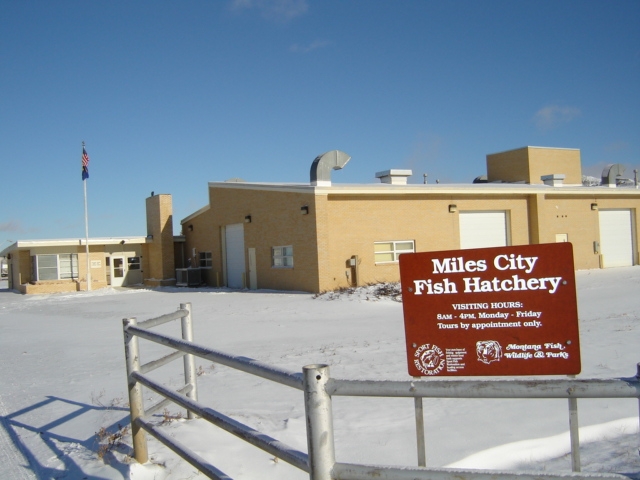
The Miles City Fish Hatchery, run by the Montana Fish, Wildlife and Parks. (Photo courtesy of Montana FWP)
Members of the Yellowstone Valley Audubon Society are sounding an alarm about several large species of migratory birds, including osprey, which have all but disappeared near a state fish hatchery after it repeatedly obtained permits to kill the birds, which state officials said interfered with non-native fish farming.
The Yellowstone Valley Audubon Society is suing the U.S. Fish and Wildlife Service for issuing the permits without proper consideration of the impacts the killing would have on the species, and say the department violated its own rules by using the permits repeatedly during a 10-year period when federal law treats the permits as a temporary solution to give agencies more time to formulate a long-term plan.
The society said that osprey and other birds like the double-crested cormorants and great blue heron have disappeared from a swath of land along the Yellowstone River after the federal Fish and Wildlife Service granted the Montana Fish, Wildlife and Parks permission to kill the birds without filing any other paperwork, like an environmental assessment that would have forced the agency to consider other alternatives.
The Miles City Fish Hatchery produces non-native bass, non-native bluegill and trout for sport fishing. It is approximately 220 acres in size, and includes 49 open ponds that range from a half-acre to five acres.
The lawsuit said that between 2018 and 2020, the FWP personnel shot eight osprey, 105 Canada geese, 26 great blue heron and 16 double-crested cormorants.
“As a result of these takings, according to the Yellowstone Valley Audubon Society, the number of fledglings from known osprey nests within a 20-mile radius declined drastically, and no osprey fledglings were produced in 2018, 2019, and 2020,” the lawsuit said.
Attorneys for the group, represented by Earthjustice, said that the federal government has abandoned its own rules and has failed to take a hard look at other non-lethal alternatives to killing the migratory birds.
The Yellowstone Valley Audubon Society also has an osprey nest monitoring project, and has been involved tracking the birds since 2009.
“YVAS members actively participated in advocacy and communication efforts with Montana Fish, Wildlife and Parks and the Fish and Wildlife Service to stop the killing of migratory birds at the Miles City Fish Hatchery,” the lawsuit said.
Attorneys for the society argue that the depredation permits that have been issued are meant as short-term solutions “only approved for, at most, one year.”
“They cannot be the primary means of addressing bird depredation and must be issued in conjunction with non-lethal measures,” the lawsuit said.
The Department of the Interior, which oversees the Fish and Wildlife Service, has a policy of not commenting on pending litigation.
The Montana FWP has told the group that it has tried other non-lethal tactics to scare off the birds from the fish ponds, including a propane cannon, cracker shells, dogs, and ATVs to harass the birds, but with no success.
“A recent study, published in 2023 confirmed the impacts observed by the osprey nest monitors: The breeding population of ospreys around the fish hatchery collapsed after 3 years of lethal control,” the lawsuit said, citing a study by Marco Restani of the Montana FWP.
The FWS-authorized killing became the most common cause of death for the osprey in Montana, even outpacing electrocution from power lines .
“Shooting mortality appeared additive and the hatchery functioned as an ecological trap for nesting and foraging osprey,” the report said.
The Audubon Society also said that prior to the killing permits, the osprey population was growing along the Yellowstone River. The osprey are one of the only birds that require a live-fish diet exclusively. Osprey nests along the river had doubled but when hatchery staff started killing the birds, the population collapsed.
The lawsuit said the federal agency has never considered other non-lethal means, and that violates federal law that requires the agency to consider other alternatives.
The attorneys are asking federal court magistrate Timothy J. Cavan to declare that the actions violate the federal law, set aside the permit issued in 2024, and stop the fish hatchery from killing the birds until it has come into compliance with the federal National Environmental Policy Act.
“The Northern Rockies is meant to be a refuge for migratory birds, not a killing field,” said Emily Qiu, Earthjustice attorney, representing the Audubon Society. “The Fish and Wildlife Service’s long-term reliance on lethal actions has devastated migratory birds, including osprey, run counter to the Service’s mission, and exacerbates the biodiversity crisis.”

